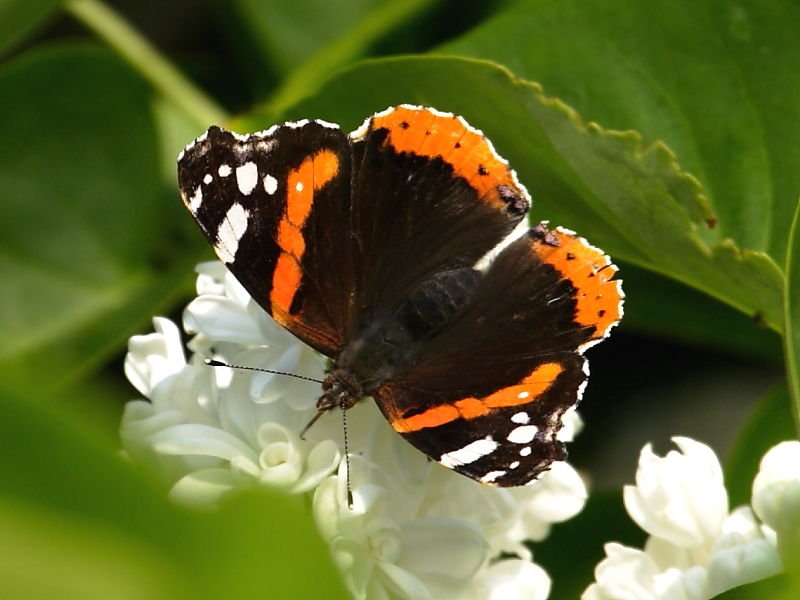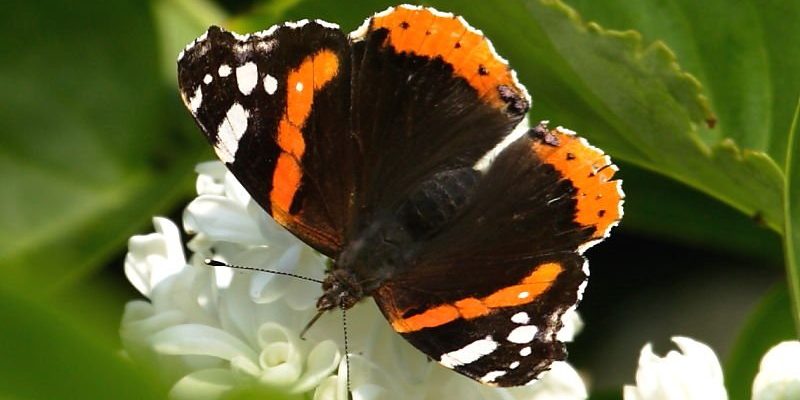
The Red Admiral Butterfly is one of those enchanting creatures that can catch anyone’s eye. With its striking colors and elegant flight, it embodies the beauty of nature right in our backyards. Imagine seeing a small, vibrant butterfly gracefully flitting from flower to flower, its orange and black wings dancing in the sunlight. That’s the Red Admiral, a butterfly that doesn’t just captivate with looks but also holds fascinating secrets about its life and habits.
This butterfly is not only a delight to observe but also a resilient survivor in the face of changing environments. Found across various regions, including North America and Europe, the Red Admiral Butterfly adapts well to different climates and conditions. Its ability to thrive in both urban gardens and wild meadows makes it an interesting subject for nature lovers and researchers alike. As you dive deeper into the world of the Red Admiral, you’ll discover how these butterflies play a crucial role in their ecosystems.
Identifying Features of the Red Admiral Butterfly
One of the first things you’ll notice about the Red Admiral Butterfly is its distinctive appearance. These butterflies have a wingspan of about 2 to 3 inches and display a striking color palette. The upper side of their wings is predominantly black, accented with bright orange bands and white spots that make them easily recognizable. When they rest, their wings are closed, creating a compact shape that can camouflage with tree bark or leaves, helping them evade predators.
But it’s not just the colors that make them stand out. The Red Admiral Butterfly exhibits a unique flight pattern characterized by rapid flaps accompanied by occasional glides. This erratic movement is not only beautiful to watch but also effective in confusing potential threats. Their agility in the air is one of the factors contributing to their survival in the wild, making them seem almost magical as they navigate through their environment.
Life Cycle of the Red Admiral Butterfly
The life cycle of the Red Admiral Butterfly is a remarkable journey that begins with the humble egg. Females lay their eggs on the underside of leaves, typically on nettles, which serve as the primary food source for their caterpillars. After a few days, the tiny caterpillars, known as larvae, hatch and start to munch on the leaves around them. This is where they grow rapidly, shedding their skin multiple times in a process called molting.
As the caterpillars continue to feed, they become plump and vibrant, often displaying a mix of greens and browns that help them blend in with their surroundings. Once they have reached their full size, they pupate, transforming into an immobile chrysalis. This stage is like nature’s little secret; inside the chrysalis, the caterpillar is undergoing a spectacular metamorphosis to become the beautiful butterfly we admire. After about two weeks, the adult butterfly emerges, ready to take on the world.
Habitat and Distribution
Red Admiral Butterflies are adaptable creatures that can thrive in a variety of habitats. You’ll often find them in gardens, parks, forests, and even urban areas. They prefer areas where their host plants, like nettles, grow, as these are crucial for their caterpillars’ development. Additionally, they are commonly spotted in moist woodland edges and sunny clearings, where they can easily access nectar from flowers.
In terms of distribution, the Red Admiral Butterfly has a wide range. In North America, they are found across the continental U.S. and Canada. Their presence extends into Europe and parts of Asia, making them a truly cosmopolitan species. During migration, these butterflies can travel quite a distance, showing up in new areas as they seek out favorable climates and abundant food sources.
Feeding Habits and Diet
The diet of the Red Admiral Butterfly varies throughout its life stages. As caterpillars, they feed primarily on nettles, which provide the necessary nutrients for growth. These plants are rich in proteins and other essential compounds, making them an excellent source of energy. Once they metamorphose into adults, their diet shifts to nectar, which they obtain from a range of flowering plants. Favorites include zinnias, butterfly bushes, and asters.
Adult Red Admirals are often seen sipping nectar from flowers, which not only sustains them but also plays a vital role in pollination. As they move from blossom to blossom, they help fertilize plants by transferring pollen, contributing to the health of local ecosystems. This interaction is a reminder of how interconnected nature is; each species plays its part, no matter how small.
Behavior and Social Structure
Behaviorally, Red Admiral Butterflies exhibit some fascinating traits. They are known for their territorial nature, especially during mating season. Males will often chase away rivals to protect their territory, ensuring they attract the attention of potential mates. This spirited behavior is a crucial part of their reproductive strategy.
Interestingly, Red Admirals are also quite social. You’ll often see them congregating in groups, especially at nectar sources or basking in the sun. This social interaction helps them communicate and can also play a role in mate selection, as butterflies observe the fitness of potential partners. Their social structure is a beautiful illustration of cooperation and competition, both vital for survival.
Migration Patterns
Migration is another captivating aspect of the Red Admiral Butterfly’s life. In North America, they are known to migrate south as the temperature drops, seeking warmer climates during the winter months. This journey can take them thousands of miles, and it’s not uncommon to spot them in your garden after they’ve traveled such long distances.
During migration, Red Admirals often travel in groups, which offers protection against predators. Their ability to navigate and adjust to changing weather conditions is impressive, showcasing the resilience of these butterflies. Once they reach their destination, they will find suitable habitats to breed and continue their life cycle, illustrating the incredible journey these butterflies undertake each year.
The Role of Red Admirals in Ecosystems
The Red Admiral Butterfly plays a significant role in maintaining ecological balance. As pollinators, they help fertilize flowers and support the growth of various plants. This not only aids in plant reproduction but also supports the broader food web, benefiting other animals and insects that depend on plants for survival.
Moreover, their diet of nettles as caterpillars helps to manage plant populations. By feeding on these plants, they prevent overgrowth, allowing for a more balanced ecosystem. This highlights the interconnectedness of species; every creature, from the tiniest insect to the largest animal, has a role to play in sustaining life on Earth.
Common Threats and Conservation Efforts
Despite their resilience, Red Admiral Butterflies face several threats in their natural habitats. Habitat loss due to urban development and agricultural practices is a significant concern, as it reduces the availability of both food sources and suitable breeding areas. Additionally, climate change poses risks, such as altering migration patterns and affecting the availability of nectar and host plants.
Conservation efforts are essential to ensure the survival of these beautiful butterflies. Planting native flora in gardens can provide essential nectar sources and host plants for caterpillars. Many organizations are working to educate the public on the importance of butterflies in ecosystems, promoting habitat restoration and sustainable practices that protect these charming creatures.
Interesting Facts About the Red Admiral Butterfly
| Wingspan: | 2 to 3 inches |
| Primary Habitat: | Gardens, parks, woodlands |
| Diet: | Nectar as adults, nettles as caterpillars |
| Lifespan: | About 4 to 5 months |
| Migration: | Yes, during colder months |
The Red Admiral Butterfly is more than just a pretty face in the garden. It represents the intricate web of life and the importance of each species in maintaining balance within ecosystems. Whether you’re watching one flutter by in your yard or learning about its life cycle, there’s always something new to discover about these fascinating butterflies. They remind us of the beauty of nature and the need to protect it, one butterfly at a time.
FAQ
Where can I find the Red Admiral Butterfly?
You can find the Red Admiral Butterfly in various habitats, including gardens, parks, and woodlands. They are particularly common in areas where nettles grow, as these plants are crucial for their caterpillars. Look for them in sunny spots where they can easily access flowers for nectar!
What do Red Admiral Butterflies eat?
Red Admiral Butterflies have diverse diets depending on their life stage. As caterpillars, they primarily feed on nettles. Once they become adults, they enjoy sipping nectar from a range of flowering plants like zinnias and butterfly bushes. This diet not only sustains them but also aids in pollination.
How can I attract Red Admirals to my garden?
To attract Red Admiral Butterflies to your garden, plant native flowering plants that provide nectar. Additionally, ensure you have nettles in your garden, as these are essential for their caterpillar stage. Creating a sunny area with water sources can also invite them to visit!
Are Red Admiral Butterflies migratory?
Yes, Red Admiral Butterflies are migratory. They travel south during colder months to find warmer habitats. This migration can cover significant distances as they seek out food and suitable breeding sites, highlighting their adaptability.
What is the lifespan of a Red Admiral Butterfly?
The lifespan of the Red Admiral Butterfly typically ranges from 4 to 5 months. This includes time spent in all life stages, from egg to caterpillar, to chrysalis, and finally, to adult butterfly. Their lifespan can be affected by environmental factors, such as food availability and predation.
Why are Red Admiral Butterflies important?
Red Admiral Butterflies play a crucial role in ecosystems as pollinators. By transferring pollen from one flower to another, they help plants reproduce, which supports local biodiversity. Their caterpillar stage also helps manage plant populations by feeding on nettles, ensuring a balanced environment.
How do Red Admiral Butterflies protect themselves from predators?
Red Admiral Butterflies use various strategies to evade predators. Their coloration helps them blend in with their surroundings, especially when resting with their wings closed. Additionally, their rapid and erratic flight pattern can confuse and deter potential threats, allowing them to escape more easily.
Can Red Admiral Butterflies survive winter?
While adult Red Admiral Butterflies do not survive the winter in harsh climates, they migrate to warmer areas where they can continue to thrive. In milder climates, some may hibernate, seeking shelter in protected places until the weather warms up again.
Are Red Admiral Butterflies endangered?
Currently, Red Admiral Butterflies are not classified as endangered. However, they do face threats from habitat loss and climate change. Conservation efforts are vital to ensuring their populations remain stable and that they continue to thrive in different environments.
How can I help conserve Red Admiral Butterflies?
You can help conserve Red Admiral Butterflies by creating habitats that support their lifecycle. Plant native flowers, grow nettles, and minimize pesticide use in your garden. Supporting local conservation organizations can also help protect their environments and promote awareness about the importance of butterflies in ecosystems.

